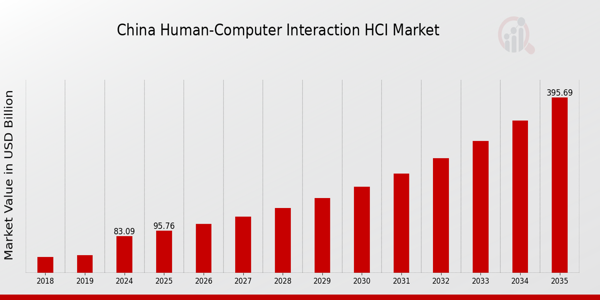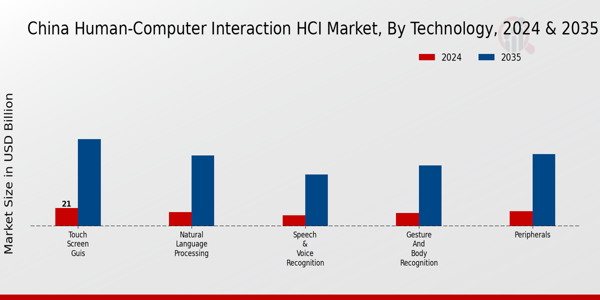China Human-Computer Interaction(HCI) Market Overview
As per MRFR analysis, the China Human-Computer Interaction(HCI) Market Size was estimated at 75.01 (USD Billion) in 2023. The China Human-Computer Interaction(HCI) Market Industry is expected to grow from 83.09(USD Billion) in 2024 to 395.69(USD Billion) by 2035. The China Human-Computer Interaction (HCI) Market CAGR (growth rate) is expected to be around 15.244% during the forecast period (2025 - 2035)
Key China Human-Computer Interaction (HCI) Market Trends Highlighted
The China Human-Computer Interaction (HCI) market is being shaped by a number of important market drivers, including rapid technological breakthroughs and increasing usage of AI across industries. The proliferation of smart gadgets and the Internet of Things (IoT) has fueled innovation in HCI, resulting in more intuitive user interfaces and personalized experiences. The Chinese government is emphasizing technical self-reliance through projects like "Made in China 2025," with an emphasis on creating local skills in HCI technologies such as speech and gesture recognition systems. This fosters an environment for continuing research and development, which is essential for improving user experiences.
Opportunities in the Chinese HCI market abound, especially as industries such as healthcare, education, and transportation seek to improve service delivery through HCI technologies. The burgeoning urban population and increasing smartphone penetration make ideal ground for applications that use HCI to boost user engagement. Furthermore, as China's population ages, there is room for HCI applications geared for senior persons, making technology more accessible and user-friendly for this demographic. Recent trends include a considerable increase in the usage of virtual and augmented reality in a variety of industries, including entertainment and instruction.
The emphasis has also turned to collaborative HCI systems, which allow users to engage smoothly across several platforms. The introduction of 5G technology in China is expected to improve the performance and capacities of HCI technologies by enabling real-time data processing, opening up new possibilities. These patterns represent a rapidly changing landscape in China's HCI market, where ongoing innovation and application development are likely to fuel future growth.

Source: Primary Research, Secondary Research, Market Research Future Database and Analyst Review
China Human-Computer Interaction (HCI) Market Drivers
Rapid Adoption of Artificial Intelligence and Machine Learning
The rapid adoption of Artificial Intelligence (AI) and Machine Learning (ML) technologies is significantly driving the growth of the China Human-Computer Interaction (HCI) Market. According to a report from the Ministry of Industry and Information Technology of China, the AI industry is expected to reach a scale of 1 trillion CNY (approximately 150 billion USD) by 2030. This growth is indicative of the increasing integration of AI and ML in various sectors, such as healthcare, finance, and retail, bolstering the demand for advanced HCI solutions.
Companies like Baidu and Alibaba are investing heavily in AI-driven interfaces, enhancing user experiences through natural language processing and visual recognition technologies. Their advancements in AI not only improve functionalities but also accelerate the adoption rates of HCI systems across diverse industries in China, thus propelling the overall market.
Increased Government Investment in Technology Infrastructure
The Chinese government has been consistently increasing its investments in technology infrastructure to support the development of the Human-Computer Interaction (HCI) Market. In 2021, the government announced plans to invest over 8 trillion CNY (approximately 1.2 trillion USD) in digital infrastructure over the next decade, promoting initiatives in artificial intelligence, big data, and cloud computing.
This strategic investment aims to build smart cities and enhance the country's digital capabilities, driving the demand for innovative HCI solutions.Major state-owned enterprises, such as China Mobile and China Telecom, are collaborating with technology providers to develop user-friendly interfaces, significantly impacting the growth of the China Human-Computer Interaction(HCI) Market.
Growing Adoption of Smart Devices and Wearable Technology
The growing adoption of smart devices and wearable technology is serving as a major driver of the China Human-Computer Interaction (HCI) Market. According to the China Internet Network Information Center, active users of wearable devices in China reached over 200 million in 2022, highlighting a surge in consumer interest and market potential.
Companies like Huawei and Xiaomi are leading the development of smart wearables that enhance user interaction through intuitive interfaces.As consumers increasingly adopt these devices, the demand for seamless HCI solutions that enhance usability and accessibility will continue to grow, significantly impacting the market's trajectory in China.
China Human-Computer Interaction (HCI) Market Segment Insights
Human-Computer Interaction (HCI) Market Technology Insights
The China Human-Computer Interaction (HCI) Market within the Technology segment is characterized by its rapid evolution and substantial investment in innovative technologies aimed at enhancing user experiences across various platforms. This domain encompasses several important fields, each contributing to the overall growth and development of effective human-computer interactions. Peripherals play a significant role in facilitating interaction, offering essential tools that augment user engagement and productivity. Touch Screen Graphical User Interfaces, being widely accepted, have transformed user experiences by providing intuitive interaction methods, leading to their dominance in consumer electronics and enterprise applications alike.
Gesture and Body Recognition technologies have emerged as noteworthy advancements, allowing users to interact with systems through natural movements, which enhances accessibility in diverse environments including healthcare and gaming. Speech and Voice Recognition technologies facilitate seamless communication between users and devices, with increasing applications in smart home systems and customer service, demonstrating a growing trend towards voice-activated interfaces. Natural Language Processing is vital in bridging language barriers, enabling machines to interpret and generate human languages effectively, thereby expanding communication possibilities within a diverse population.
Brain Computer Interfaces are at the forefront of innovative technology, offering groundbreaking ways for users to interact with computers through neural signals, promising extensive developments in assistive technologies and rehabilitation. Eye Tracking technology, crucial for understanding user behavior, is increasingly employed in usability studies and targeted advertising, assisting businesses in tailoring products to meet customer needs. Collectively, these areas illustrate the dynamic nature of the China Human-Computer Interaction (HCI) Market, where technology is pushing boundaries and redefining user experiences.
Moreover, the demand for more sophisticated human-computer interaction systems is fueled by China's emphasis on becoming a global leader in technology and innovation, further propelling advancements in this segment. The continuous integration of these technologies into daily life underlines the significance of the segment, contributing to various industries and enhancing the overall user experience, thereby underpinning the future growth of the market.

Source: Primary Research, Secondary Research, Market Research Future Database and Analyst Review
Human-Computer Interaction (HCI) Market Organization Size Insights
In the China Human-Computer Interaction (HCI) Market, the segmentation by Organization Size reveals significant insights that highlight varying dynamics and opportunities. The market comprises small and medium-sized enterprises (SMEs) and large enterprises, both of which play crucial roles in driving innovation and adoption of HCI solutions. SMEs are rapidly embracing HCI technologies to enhance productivity and user engagement, often seeking cost-effective solutions that cater to their unique needs. Meanwhile, large enterprises tend to dominate this sector, leveraging HCI for comprehensive user experience enhancements and large-scale implementations, which are vital for their competitive edge.
The increasing digital transformation initiatives within China are further propelling the demand for HCI solutions across both organization types. As the government's commitment to fostering technology-driven growth continues to expand, both SMEs and large enterprises stand to benefit significantly. The interplay between these organization sizes is also shaping the landscape of user interface design and interaction methodologies. Moreover, as user expectations evolve, the push for intuitive and efficient HCI applications will remain a driving force in this market segment, enabling both types of organizations to meet the demands of an increasingly digital world.
Human-Computer Interaction(HCI) Market Component Insights
The Component segment of the China Human-Computer Interaction (HCI) Market plays a crucial role in the overall growth and advancement of technology within the region. This segment is divided into three key areas: Hardware, Software, and Services, each contributing uniquely to market dynamics. Hardware, including devices such as touchscreens and input peripherals, is significant in enhancing user experience and engagement, making it fundamental for several industries from education to gaming.
On the other hand, the Software sector focuses on applications and platforms that facilitate interaction between users and machines, emphasizing intuitive interfaces that are becoming increasingly vital in the digital age.
Furthermore, the Services aspect encompasses technical support, consultancy, and integration tailored for businesses looking to implement HCI solutions effectively, showcasing the importance of human-centered technology and its application across diverse sectors. The integration of advanced technologies such as artificial intelligence and augmented reality within these components is driving innovation, signifying the growing trend towards more immersive and effective user experiences in China’s burgeoning digital landscape. Collectively, these elements underscore the significance of the Component segment as it aligns with broader market trends and consumer demands, ultimately shaping the future of human-computer interaction in the region.
Human-Computer Interaction (HCI) Market Application Area Insights
The China Human-Computer Interaction (HCI) Market is experiencing significant advancements across various application areas. Each sector plays a pivotal role in driving innovation and user engagement. The Healthcare sector is notably important, focusing on enhancing patient experience and improving medical diagnostics through interactive technology. Personal Computers and Smartphones continue to be a major driving force, with an increasing emphasis on user-friendly interfaces that cater to diverse demographics.
The Gaming and Entertainment segments saw robust growth, highlighting the demand for immersive experiences through virtual reality and advanced gaming controls.Meanwhile, the Smart Home and White Goods market is growing, emphasizing the integration of HCI in daily appliances for improved convenience and efficiency.
Wearables are gaining traction as consumers seek health monitoring and connectivity options. In education, interactive tools are transforming traditional learning, engaging students through a more hands-on approach. The Automotive sector is integrating HCI in vehicles for enhanced safety and user experience, driving forward-looking innovations in transportation. Lastly, the Industrial sector is focusing on improving productivity through advanced HCI systems that facilitate better human-machine collaboration.Collectively, these sectors showcase the diverse applications and critical importance of the China Human-Computer Interaction (HCI) Market in the modern economy.
China Human-Computer Interaction (HCI) Market Key Players and Competitive Insights
The China Human-Computer Interaction (HCI) market is experiencing significant growth and transformation due to advancements in technology, increasing demand for user-centric designs, and innovative solutions enhancing user experience across various sectors. As digital interfaces become an integral part of everyday life, businesses are prioritizing HCI to develop intuitive products and services that facilitate better human interaction with technology. This has led to a competitive landscape characterized by rapid innovation, collaborations, and investments aimed at creating more engaging and effective user experiences.
Key players in this market are focusing on research and development, enhancing their product offerings, and leveraging emerging technologies such as artificial intelligence and machine learning to improve human-computer interactions.
Tencent is a key player in China's Human-Computer Interaction (HCI) market, combining its expertise in social media, gaming, and artificial intelligence (AI) to improve user engagement through intuitive interfaces. It simplifies communication and digital payments by integrating natural language processing, gesture input, and voice interaction with platforms such as WeChat. Tencent's Timi Studios is the industry leader in immersive gaming UI/UX design, with a focus on real-time responsiveness and adaptive gameplay interfaces. The company also invests in XR and virtual assistants, which allow for more emotional and contextual interactions with users.
Tencent has established itself as a pioneer in establishing accessible, user-centric digital ecosystems that transform how Chinese people engage with gadgets and software by incorporating HCI technology into everyday consumer apps and entertainment.
Baidu is a key player in China's Human-Computer Interaction (HCI) business, with significant investments in AI, including natural language processing and speech technologies. It's DuerOS conversational AI technology enables voice assistants in smart speakers, appliances, and cars, allowing humans and machines to engage seamlessly through voice commands. Baidu's autonomous driving branch also includes advanced HCI features including driver monitoring systems, visual dashboards, and multi-modal communication. The company's primary focus is on developing AI that can understand and respond naturally to human intent, such as sentiment detection and contextual awareness.
Baidu continues to push the growth of intelligent, human-centered interaction technologies in smart living, mobility, and enterprise applications by integrating intuitive, voice-first, and gesture-enabled interfaces throughout its product ecosystem.
Key Companies in the China Human-Computer Interaction(HCI) Market Include
- Baidu
- Huawei
- Tencent,
- iFlytek
- SenseTime,
- Xiaomi,
- UBTECH Robotics
- ByteDance
China Human-Computer Interaction(HCI) Market Industry Developments
The China Human-Computer Interaction (HCI) Market has seen significant developments in recent months. In June 2025, China recently completed its first clinical trial of a semi-invasive brain-computer interface (BCI) technology, allowing users to control external equipment directly through brain impulses. China is the second country, after the United States, to reach this advanced degree in BCI development, indicating tremendous progress in human-machine integration and neuro-interaction technology. On March 20, 2025. Tiantan Hospital in Beijing successfully implanted "Bei Nao No. 1," a wireless cortical BCI developed in China.
Patients with paralysis and ALS were able to communicate in Chinese through thought-based movements. This launch establishes a new national record for multi-channel human brain implants, highlighting China's emerging leadership in invasive HCI technology.
Mergers and acquisitions have shaped the landscape as well, most notably when Alibaba acquired a stake in a promising HCI startup in August 2023 to bolster its AI capabilities. In the past few years, SenseTime and iFLYTEK have expanded their reach through collaborations focusing on facial recognition and natural language processing, with notable developments occurring in April 2022 when Baidu opened its first dedicated HCI research lab. This dynamic environment reflects China's intent to be at the forefront of HCI, fostering innovation that directly impacts industries such as e-commerce, smart technology, and AI development.
China Human-Computer Interaction(HCI) Market Segmentation Insights
Human-Computer Interaction(HCI) Market Technology Outlook
- Peripherals
- Touch Screen GUIs
- Gesture and Body Recognition
- Speech & Voice Recognition
- Natural Language Processing
- Brain Computer Interface
- Eye Tracking
Human-Computer Interaction(HCI) Market Organization Size Outlook
Human-Computer Interaction(HCI) Market Component Outlook
- Hardware
- Software
- Services
Human-Computer Interaction(HCI) Market Application Area Outlook
- Healthcare
- Personal Computers & Smartphones
- Gaming & Entertainment
- Smart Home & White Goods
- Wearables
- Education
- Automotive
- Industrial
| Report Attribute/Metric Source: |
Details |
| MARKET SIZE 2023 |
75.01(USD Billion) |
| MARKET SIZE 2024 |
83.09(USD Billion) |
| MARKET SIZE 2035 |
395.68(USD Billion) |
| COMPOUND ANNUAL GROWTH RATE (CAGR) |
15.244% (2025 - 2035) |
| REPORT COVERAGE |
Revenue Forecast, Competitive Landscape, Growth Factors, and Trends |
| BASE YEAR |
2024 |
| MARKET FORECAST PERIOD |
2025 - 2035 |
| HISTORICAL DATA |
2019 - 2024 |
| MARKET FORECAST UNITS |
USD Billion |
| KEY COMPANIES PROFILED |
JD.com, Dahua Technology, Tencent, ZTE, Huawei, iFLYTEK, SenseTime, Ping An Technology, Baidu, Xiaomi, Megvii, Lenovo, Sogou, Neusoft, Alibaba |
| SEGMENTS COVERED |
Technology, Organization Size, Component, Application Area |
| KEY MARKET OPPORTUNITIES |
AI-driven user experience design, Voice recognition technology integration, Augmented reality applications expansion, Gesture-based interaction innovations, Accessibility-focused interface development |
| KEY MARKET DYNAMICS |
rapid technological advancements, increasing consumer expectations, growing mobile device usage, emphasis on user experience, rising demand for accessibility solutions |
| COUNTRIES COVERED |
China |
Frequently Asked Questions (FAQ):
The market is expected to be valued at 83.09 USD Billion in 2024.
By 2035, the market is anticipated to reach a valuation of 395.68 USD Billion.
The market is projected to grow at a CAGR of 15.244% between 2025 and 2035.
Major players include JD.com, Tencent, Huawei, Alibaba, and iFLYTEK.
In 2024, Touch Screen GUIs are valued at 21.0 USD Billion, making them the highest segment.
The market size for Gesture and Body Recognition technology is expected to reach 70.0 USD Billion by 2035.
Growth is driven by technological advancements and increasing demand for user-friendly interfaces.
Speech & Voice Recognition technology is expected to be valued at 12.59 USD Billion in 2024.
By 2035, the market for Natural Language Processing technology is anticipated to be valued at 81.75 USD Billion.
Challenges include rapid technological changes and maintaining user privacy and security.
















